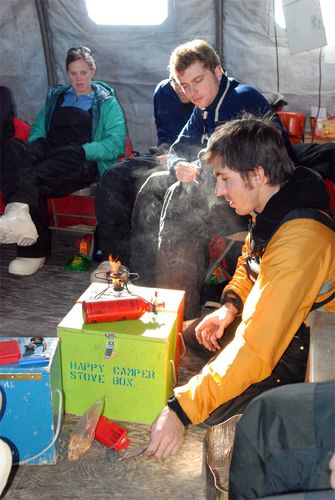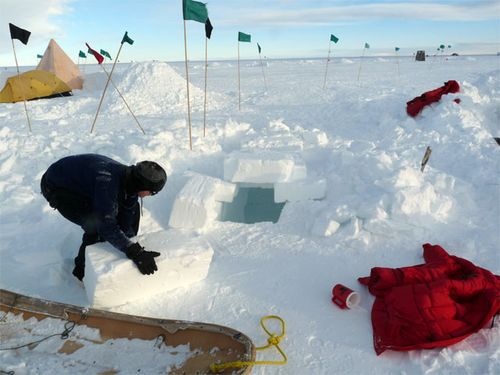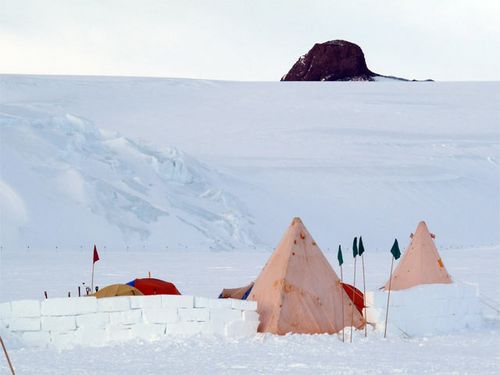Today I began "Happy Camper" training. Now, you may be wondering just what this is and to be honest, so was I. This is a two day training that will prepare you to survive in case you get stuck outside in Antarctica. The chances of this are much greater than you might think. If we go on a day trip and the weather changes and the winds really pick up, then the helicopter won't be able to return and pick us up. It might be necessary for us to spend a night out in the field.Since this is a real possibility there are procedures to help you deal with this situation. Every time you travel somewhere, even for a few hours, you take a Survival Kit. This is a large red bag that contains a tent for two, two sleeping bags, a portable stove, some food, and a tarp. It may not sound like much but you will be really glad to have it if you get stuck in bad weather.
Our group of "Happy Campers" consisted of twenty people. I was absolutely thrilled when I walked into the classroom and saw Jackie Ham, another PolarTREC teacher. She had just arrived in Antarctica the day before. We had about two hours of training to help prepare us for what we were about to endure. Everyone then piled into vehicles and we went to Snow City.
 Everyone arrived at Snow City with the ECW gear and a lot of anticipation.
Everyone arrived at Snow City with the ECW gear and a lot of anticipation.
We all walked to the Instructors' Hut or I-Hut which seemed to be about half a mile away. After a lunch of sandwiches, chips, juice, and chocolate bars it was time to get down to business.
One of the things that you need to survive is fire. This will help keep you warm and allow you to have hot food and drink. Nick, one of our instructors demonstrated how to start the stove. It was not very difficult but you have to remember that you will probably be trying to light it in strong winds.
 Our instructor, Nick, demonstrates the proper and safe way to light a camp stove. It is essential that you have fire to survive a harsh Antarctic storm.
Our instructor, Nick, demonstrates the proper and safe way to light a camp stove. It is essential that you have fire to survive a harsh Antarctic storm.
It was now time to go and set up camp. We all walked back to Snow City to set up camp. We carried or dragged all of the necessary equipment. This included a sleep kit for each person that contained a sleeping bag, a fleece bag, and two pads. We lined up all of the supplies to stay organized.
 Our supplies included our ECW gear, sleeping kits, shovels, saws, and banana sleds to carry things around.
Our supplies included our ECW gear, sleeping kits, shovels, saws, and banana sleds to carry things around.
Next, our instructors, Nick and Brian, taught us the components of a successful campsite. The first thing we did was to set up tents. We set up two Scott tents and five mountain tents. Each tent then needed to be staked into the ground to prevent it from blowing away if the wind was strong.
 The camp included two Scott tents and five mountain tents. We used metal ice stakes and rope to secure the tents.
The camp included two Scott tents and five mountain tents. We used metal ice stakes and rope to secure the tents.
The yellow tent is called a Scott tent because it is of the same design as the ones used 100 years ago by Robert F. Scott, the great Antarctica explorer. The Scott tent is one of the best tents suited for the Antarctic environment. If you would like to read about Scott's incredible adventures in Antarctica go to http://www.south-pole.com/p0000089.htm.
The next step was to build a snow wall to prevent the wind from destroying our camp. It required cutting out large, uniform blocks of snow. It was hard work but well worth the effort.
 We had to cut out large pieces of snow that were rectangular in shape and about two feet long. The blocks were then stacked to form a wall that would block the wind.
We had to cut out large pieces of snow that were rectangular in shape and about two feet long. The blocks were then stacked to form a wall that would block the wind.
We also needed to start some stoves to boil water for food and drinking. Dinner consisted of freeze-dried meals and hot chocolate or tea. We also had plenty of chocolate bars.
Some people decided that they wanted to make other sleeping arrangements. One choice was to sleep in a quinzee which is a combination igloo and snow hut. We piled all of our sleeping kits in a big pile and then shoveled snow on top of them until the snow was over 12 inches deep. We let the mound settle for three hours and then we dug a hole and pulled the sleeping kits out. We then had a couple of people go inside and smooth out the interior. Two of the guys used the quinzee as their accommodations that evening. It is very dark but rather warm.
 We piled up the sleeping kits and then shovelled snow on top of the pile until it was at least twelve inches deep. It was a lot of fun to build a big snow pile and the result was a warm place for two people to sleep.
We piled up the sleeping kits and then shovelled snow on top of the pile until it was at least twelve inches deep. It was a lot of fun to build a big snow pile and the result was a warm place for two people to sleep.
Another choice that you had was to make a snow trench. This involved digging a deep hole in the snow and then building a roof over the hole. It took most people three hours to build their trench. It was hard work and their reward was the opportunity to sleep outside in the snow. Who would pick this?
 Building a snow trench involved digging a hole that was shaped like a grave. It then required that you create a roof using whatever you had available. Noah used a banana sled to brace his blocks of snow.
Building a snow trench involved digging a hole that was shaped like a grave. It then required that you create a roof using whatever you had available. Noah used a banana sled to brace his blocks of snow.
You'll have to read tomorrow's journal to see where I slept. I will leave you with a picture of our camp. It was definitely hard work but the final result looks lovely.
 Our lovely camp at the end of a long, hard day.
Our lovely camp at the end of a long, hard day.
